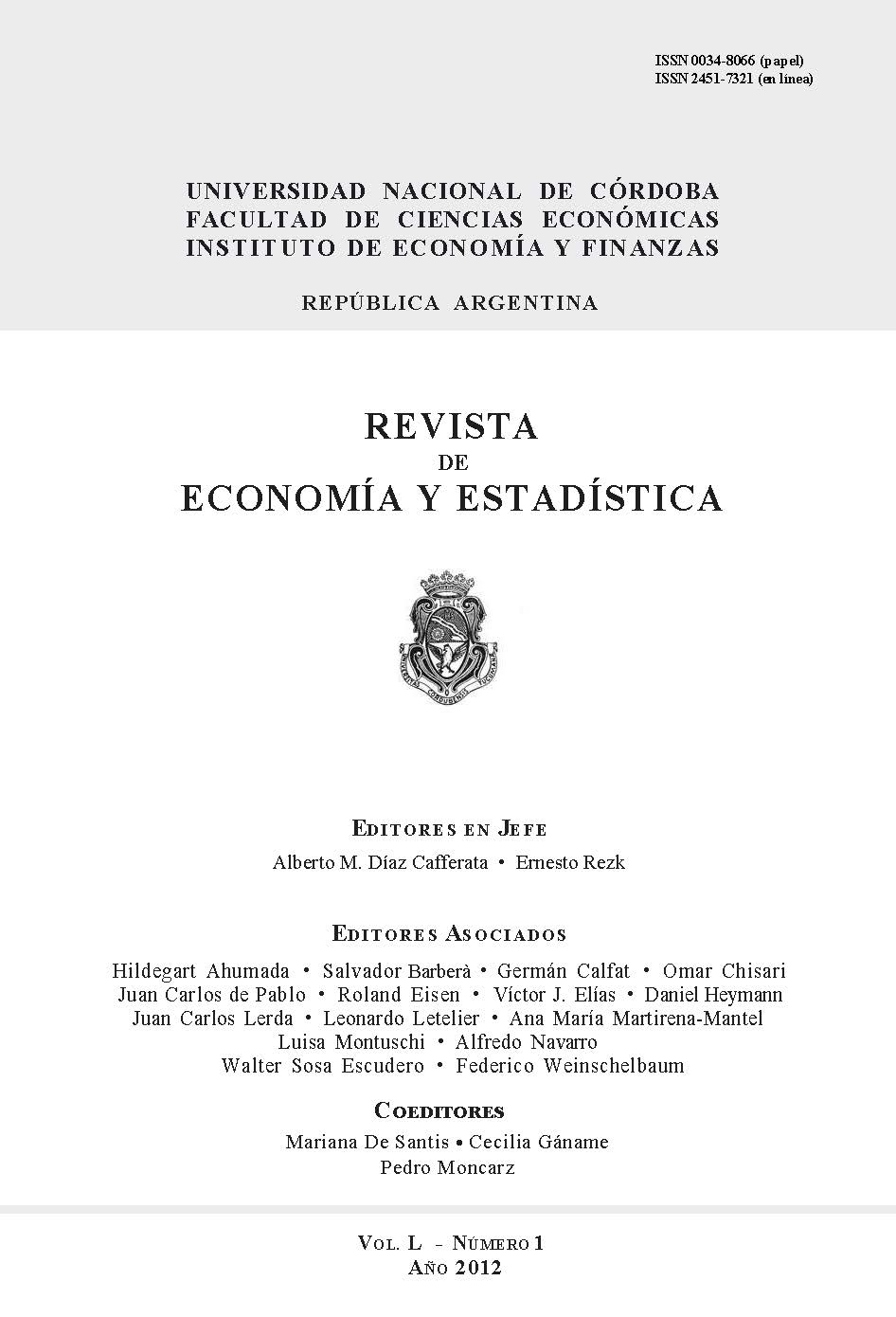Exportaciones y Productividad: ¿El destino importa?
DOI:
https://doi.org/10.55444/2451.7321.2012.v50.n1.10250Palabras clave:
productividad total de los factores, exportaciones, destino de las exportaciones, auto-selección , aprendizaje por exportarResumen
En este trabajo se analiza el efecto del destino de las exportaciones sobre la productividad total de los factores de las empresas manufactureras uruguayas, para el periodo 1997-2006. Se estudian dos efectos: autoselección y aprendizaje a través de las exportaciones. Se encuentra evidencia de autoselección con un efecto mayor para las empresas que exportan a los países desarrollados. Sin embargo, aplicando la metodología de grupos de transición, a efectos de mitigar los problemas de endogeneidad, no hay evidencia de que las exportaciones a países desarrollados aumente la productividad a través del aprendizaje por exportar. Sin embargo, si hay evidencia de aprendizaje por exportar para aquellas empresas que empiezan a exportar a países de la región, menos desarrollados. Estos hallazgos sugieren una estrategia internacional en la cual las firmas logran ganancias de productividad exportando a mercados con menores costos de entrada, y una vez que han adquirido experiencia-aprendido- y aumentado su productividad, están en una mejor posición para entrar en los mercados de los países desarrollados.
Descargas
Referencias
Aghion, P., R. Blundell, R. Griffith, P. Howitt, y S. Prantl., (2009). "The effects of entry on incumbent innovation and productivity", The Review of Economics and Statistics. 91 (1), pp. 20-32.
Alvarez, R., y R. A López., (2005). "Exporting and performance: evidence from Chilean plants". Canadian Journal of Economics/Revue canadienne d’économique. 38 (4), pp. 1384-1400.
Aw, B.Y. y Hwang, A.R., (1995). "Productivity and the export market: A firm-level analysis". Journal of Development Economics, 47(2), pp.313–332.
Bernard, A. B, y J. Bradford Jensen, (1999). "Exceptional exporter performance: cause, effect, or both?". Journal of International Economics. 47 (1) pp. 1-25.
Bernard, A.B. y Wagner, J., (1997). "Exports and success in German manufacturing". Review of World Economics, 133(1), pp.134–157.
Bittencourt, G., y M. Vaillant., (2001). "Oferta Exportable en el Uruguay. Empresas: ¿Quiénes venden?". Documento de trabajo, mimeo. Departamento de Economía, FCS, UDELAR, Montevideo.
Boermans, M. A., (2010). "Learning-by-Exporting and Destination Effects: Evidence from African SMEs", Applied Econometrics and International Development, 13 (2), pp. 149-168
Clerides, Sofronis K., Saul Lach, y James R. Tybout., (1998). "Is Learning by Exporting Important? Micro-Dynamic Evidence from Colombia, Mexico, and Morocco". Quarterly Journal of Economics 113 (3) pp. 903-47.
Da Costa Ferré, L., (2008). "Diferenciales de productividad según orientación exportadora de las empresas: ¿se cumple la autoselección y el aprendizaje?" Documento de Trabajo No. 07/08, Departamento de Economía, FCE, UdelaR.
De Loecker, J., (2007). "Do exports generate higher productivity? Evidence from Slovenia". Journal of International Economics 73 (1) pp. 69-98.
Delgado, M.A., Farinas, JC, Ruano, S. (2002). "Firm productivity and export markets: a non-parametric approach". Journal of International Economics, 57(2), pp. 397-422.
Eaton, J., S. Kortum, y F. Kramarz. (2008). "An anatomy of international trade: Evidence from French firms". National Bureau of Economic Research. NBER Working Paper No. 14610.
Fernandes, A.M., y A.E. Isgut., (2007). "Learning-by-Exporting Effects: Are They for Real?". MPRA Paper 3121, University Library of Munich, Germany.
Girma, S., D. Greenaway, y R. Kneller., (2004). "Entry to export markets and productivity: A microeconometric analysis of matched firms". Review of International Economics. 12 (5) pp. 855-66.
Granér, M., y A. Isaksson., (2009). "Firm Efficiency and the Destination of Exports: Evidence from Kenyan Plant-level Data".The Developing Economies. 47 (3) pp. 279-306.
Griffith, R., S. Redding, y J. Reenen., (2004). "Mapping the two faces of R&D: Productivity growth in a panel of OECD industries". Review of Economics and Statistics. 86 (4) pp. 883-95.
ISGEP, International Study Group on Exports and Productivity., (2008). "Understanding Cross-Country Differences in Exporter Premia: Comparable Evidence for 14 Countries". Review of World Economics. 144 (4) pp. 596-635.
Kraay, A., (1999). "Exports and economic performance: evidence from a panel of Chinese enterprises". Revue d’Economie du Developpement, 1(2), pp.183–207.
Levinsohn, J., y A. Petrin, (2003). "Estimating Production Functions Using Inputs to Control for Unobservables". Journal of Development Economics 70 pp. 317-41.
Mukim, M., (2011). "Does exporting increase productivity? Evidence from India". LSE working papers. Disponible en: http://personal.lse.ac.uk/mukim/mu kim_jmp.pdf.
Olley, S., y A. Pakes., (1996). "The dynamics of productivity in the telecommunications equipment industry". Econometrica. 64 (6) pp. 1263-97.
Peluffo A. (2008). "Trade and Technology Progress: An Analysis For Uruguay". Revista de Economía y Estadìstica, vol. XLVI, no. 2, pp. 103 - 139.
Pisu, M., (2008). "Export destinations and learning-by-exporting: Evidence from Belgium", Working Paper Research 140, National Bank of Belgium.
Trofimenko, Natalia., (2008). "Learning by Exporting: Does It Matter Where One Learns? Evidence from Colombian Manufacturing Firms". Economic Development and Cultural Change. 56 (4) pp. 871-94.
Verardi, Vincenzo, y Joachim Wagner., (2012). "Productivity Premia for German Manufacturing Firms Exporting to the Euro-Area and Beyond: First Evidence from Robust Fixed Effects Estimations". The World Economy. 35 pp. 694–712.
Wagner, J., (2007). "Exports and productivity: a survey of the evidence from firm-level data". The World Economy 30 (1) pp. 60-82.
Descargas
Publicado
Número
Sección
Licencia
Derechos de autor 2012 Barboni, Nicolas Ferrari, Hanna Melgarejo, Adriana Peluffo

Esta obra está bajo una licencia internacional Creative Commons Atribución-NoComercial-SinDerivadas 4.0.
Aquellos autores/as que tengan publicaciones con esta revista, aceptan los términos siguientes:
Los autores/as conservarán sus derechos de autor y garantizarán a la revista el derecho de primera publicación de su obra, el cuál estará simultáneamente sujeto a la Licencia Creative Commons Atribución-NoComercial-SinDerivar 4.0 Internacional que permite a terceros compartir la obra siempre que se indique su autor y su primera publicación esta revista.
Los autores/as podrán adoptar otros acuerdos de licencia no exclusiva de distribución de la versión de la obra publicada (p. ej.: depositarla en un archivo telemático institucional o publicarla en un volumen monográfico) siempre que se indique la publicación inicial en esta revista.
Se permite y recomienda a los autores/as difundir su obra a través de Internet (p. ej.: en archivos telemáticos institucionales o en su página web) antes y durante el proceso de envío, lo cual puede producir intercambios interesantes y aumentar las citas de la obra publicada. (Véase El efecto del acceso abierto)














